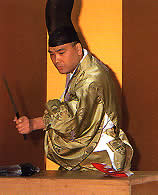京洛の地、ここ「糺森」は下鴨・高野川と加茂川が、
相交わる只州が地名の由来とか。
のちに偽りを糺すという意の字があてられた
社の森でございます。
江戸期を通じて納涼の場としても名高く御手洗川・
泉川のほとりにその風情が色濃くただよっております。

京懐石 吉泉は、この清き地にあって、
おもてなしの正統を真心もって糺すことに
精進いたしております。

| 
|

九歳にして調理する歓びを知り、この道に入る。
のちに京へあがり、茶道、華道、香道、書、詩歌と、
感動を練磨し、生間流式包丁などの有職料理、
カロリー計算を考えた糖尿病のための京懐石、
海外に京料理の何たるかをPRするための活動など、
温故知新の心を忘れず、常に新しい分野を志す。
平成11年7月放送の「料理の鉄人」に出場。
鱧対決にて、和の鉄人森本正治に完勝する。
また、その卓越した鱧切の腕は審査員を唸らせた。
|
過去には、NewYorkTimes紙でも紹介され、
海外からのお客様も多数ご来店いただいております。
以下は、NewYorkTimes紙からの引用です。
Daniel Goleman, Tea Ritual (The New York Times, October
5, 1986)
…While there are many restaurants that can claim to serve
kaiseki, the purest form requires reservations in advance
for a meal that can take hours and can cost several hundred
dollars a person. For those on a more modest budget, KICHISEN,
a new kaiseki restaurant in Kyoto, offers full
meals from about *1$30 to $50 for lunch $50 to $78 for dinner,
KICHISEN (Phone: 075-711-6121) is on the Shimogamo-hon-dori
(street), opposite and just south of the Kyoto Prince Hotel.*2
Reservations are needed, and be sure to arrive promptly;
kaiseki dishes are cooked and served in a carefully
timed order.
Copyright c1986 by The New York Times Co.
Reprinted by permission.
 |
2 / 5 |
 |
